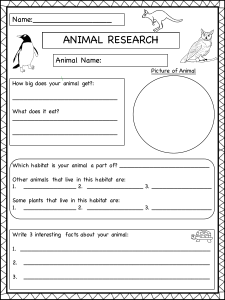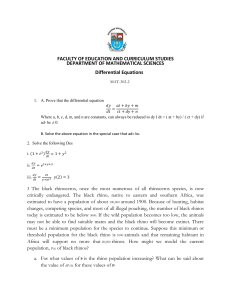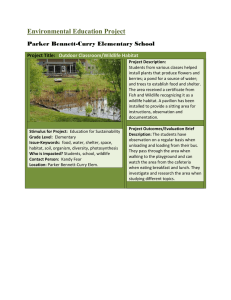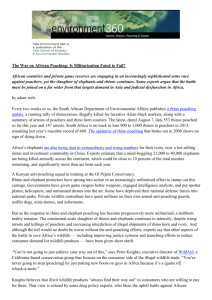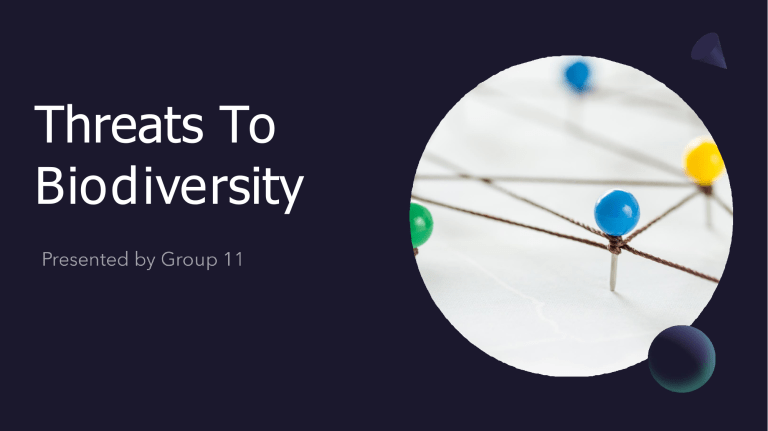
Threats To Biodiversity Members Nilanjan Paul Topics Covered Biological Invasion Poaching M an-wildlife conflict Habitat Loss Biological Invasion Nikita BIOLOGICAL INVASION THE SPREAD OF ORGANISM OR SPECIES INTO AN AREA FORMELY FREE OF IT TYPICALLY WITH DETRIMENTAL EFFECT SUCH AS DISPLACEMENT OF NATIVE SPECIES ETC. INVASIVE SPECIES INVASIVE SPECIES ARE DEFINED AS NONNATIVE SPECIES OR ALIEN SPECIES WHOSE INTRODUCTION TO NEW AREAS RESULT IN HARMFUL EFFECTS ON BIODIVERSITY. EX-BURMESE PYTHON, COMMON CARP, WILDBOAR, EUROPEAN STARLINGS. INVASIVE SPECIES SPREAD THEY ARE PRIMARILY SPREAD BY HUMAN ACTIVITIES OFTEN UNINTENSIONALLY THROUGH MEANS SUCH AS: 1. TRAVEL 2. WATER TRANSPORT 3. SCIENTIFIC RESEARCH CHARACTERISTICS OF INVASIVE SPECIES HIGH REPRODUCTION HIGH ABUNDANCE TOLERATE TO VARIETY OF HABITAT MIGRATE EASILY SMALL BODY SIZE GOOD COMPETITORS The Impacts? YUNNAN LAKE NEWT Environmental Impact 1. REDUCE NATIVE BIODIVERSITY 2 . A LTERATIO N O F NUTRIENT C YC LE 3. SPREAD OF DISEASE 4. REDUCE EC O SYSTEM STA BILITY Economical Impact 1. HAMPER TRANSPORTATION 2. REDUCE LIVESTOCK AND LAND VALUES 3. REDUCE AGRICULTURAL PRODUCTIVITY WITCHWEED SOCIAL IMPACT 1. POOR REVENUE THROUGH RECREATION 2. HEALTH IMPACT EMERALD ASH BORER Biggest Example Man-Wildlife Conflicts Presented by Sachin(FE21A I151) What is "ManWildlife conflict" ? Why is humanwildlife conflict on the rise? Impacts Impact on Farmers In the picture : Thaba Sarki, a farmer in Nepal, guards crops against wildlife incursions. Impact on Wildlife Lost Human Lives Tigress "Avni" Case The Coexistence In ord er to red uce human-wild life conflict, we must reassess the relationship—and especially the direct interactions—between people and wildlife to improve our coexistence in the future. Human-wildlife conflict will always exist as our world becomes increasingly crowded; however, effective, wellp lanned management and holistic and integrated approaches can reduce and minimize conflict in the long term. India’s First Animal Bridges In DelhiMumbai Expressway NH-44, Madhya Pradesh Plant a Tree Reduce, Reuse and Recycle Avoid the use of Plastic Protect our Planet Volunteer for cleanups in your community. Conserve Water Save electricity Poaching of Wildlife Presented by Rakesh Sabale (FE21AI152) What is poaching? • Poaching is the illegal taking of wildlife and violating laws in the area by doing so • Started in the 1700's in Europe (Image Source: National Geography African endangered species LEFT: African Black Rhino (2,500 left) ABOVE: African elephant (470,000 left) LEFT: African White Rhino (20,000 left) Two African boys holding the horn of an elephant that was just killed. Why are these animals important? • Elephants considered the 'keystone species in African landscape' • Elephants shape the landscape naturally • They can create more waterholes/ sources for animals and humans can use • Their manure is good for fertilizer • Rhinos and Elephants both attract many tourists • Rhinos are "mega herbivores" they eat lots of grass, which can shape the landscape as well Why kill them? Who is killing/selling them? • Generally the poorer community kills and sells the tusks/horns of these animals • One pound of ivory can cost 1,500$ on the black market, while one tusk can weigh 250 pounds Why? For what? • Over all both animals are killed for their horns • In some countries, like Vietnam, owning an ivory horn is a sign of wealth • Used for piano tiles, decoration, jewelry, pool balls and sculptures • Used for medicine in some parts of Asia Some examples of uses of ivory (LEFT)Ivory can be used as a form of decoration, by carving into it (LEFT) Piles of ivory, being cleaned for selling (ABOVE) Ivory piano keys were very common until made illegal The major effects of poaching in Africa • Massive population decrease • Decrease in the tourism business • The extinction of a key species will cause a major unbalanced ecosystem in Africa What is being done to prevent poaching/extinction? • The South African Dept. Of Environmental Affairs has placed stricter regulations on the rhino horn. • China's Chief Executive, Mr. Leung making efforts to ban the import and export of ivory • Ad campaigns and political cartoons (seen below) • Injecting dye into the tusks and horns of these animals is helping increase the population • Using drones to keep watch of the animals Dye injected into rhino and elephant horns to prevent poaching Drones used to control Rhino poaching Current Rhino Statistics from SaveTheRhino Habitat loss by aditya Habitat Loss • A bulldozer pushing down trees is the iconic image of habitat destruction. Other ways people directly destroy habitat include filling in wetlands, dredging rivers, mowing fields, and cutting down trees. • Major causes for habitat loss are agriculture, land conversion for development, water development, pollution, climate change. • In 10,000 BC, 40% of Earth’s surface was completely wild and free from human influence – this consisted of pristine untouched forest, wild grasslands, shrubs and deserts. • The world has lost one-third of its forests since the last ice age. • We often think of environmental damage as a modern problem, but humans have been transforming the planet for millennia. • The world has lost one-third of its forests since the last ice age. • Humans very quickly became the dominant land user, reaching 5% of land use around the year 900; 10% by 1700; 25% by 1880; up to half of all land today. • Since agriculture is the dominant driver of habitat loss we need to use less land for food. We can achieve this through dietary changes (less livestock) and improved yields.

